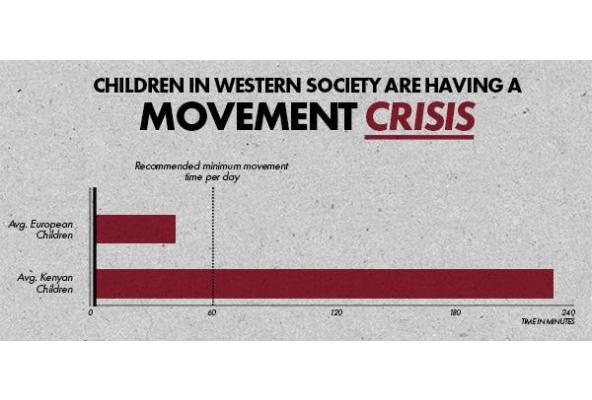We have a movement crisis in our midst. In the most advanced, privileged countries in the world, our kids are not meeting the minimum requirements for healthy movement, and it’s having a knock on effect.
It’s thought that children should get at least 60 minutes of vigorous movement a day; that’s an hour a day that kids should be running around. The average child in Europe gets just 20 to 40 minutes physical activity a day (Konstabel 2014). In Kenya, it’s nearly 4 hours. (Ojambo, 2013)
Active kids grow up physically healthier than inactive kids. Studies also suggest that daily physical exercise has a positive effect on cognitive brain function, concentration levels in school, and can even help with mental health in later life. An inactive lifestyle can lead to, not only weight problems, but has also been linked to an increased risk of heart problems in adulthood. (Hillman, 2008)
It’s estimated that children in the USA now spend up to 6 hours a day on computers, phones, watching TV or playing on consoles. (Harris, 2007) The kids of today are the first generation to be born with internet access and have an endless stream of easily available consumer technology at their fingertips, so it’s easy to see why the digital age has seen such a surge in sedentary leisure activities.
We were all born to move and have the evolutionary potential to stretch ourselves much further than many of us do. Look at a young child on the monkey bars; how many adults can move with such ease? Young children are nimble and flexible little creatures, but as we get older, we’re told to sit down, shut up, knuckle down and listen up. We can easily get out of the habit of the kind of physical activity that comes easy to kids, and we can lose the flexibility and energy of youth.


The solution is simple, and it’s all in our hands. Kids need to move more, so get them out of their seats, get them outside; get them running, climbing trees and reconnecting with their natural environment. Fun, silly playtime should not be reserved for toddlers, or even for kids. Playtime is for all of us, for all ages, and we should be leading by example.
Let’s put physical activity back into the daily habits of family life, and change the habits of the sedentary generation. Let’s get kids to fall in love with nature, with movement, and open their eyes to the possibilities that come from a healthy, active lifestyle.
It’s time to make a change. Let’s get our kids moving.
Sources
Ojiambo, R., Gibson, A. R., Konstabel, K., Lieberman, D. E., Speakman, J. R.,. Reilly, J. J., Pitsiladis, Y. P., 2013, Free-living physical activity and energy expenditure of rural children and adolescents in the Nandi region of Kenya, Annals of Human Biology, Vol. 40, No. 4 , Pages 318-323 (doi:10.3109/03014460.2013.775344).
Konstabel, K,. Veidebaum, T., Verbestel, Moreno, LA., Bammann, K., Tornaritis, M., Eiben, G., Molnár, D., Siani A., Sprengeler, O., Wirsik, N., Ahrens, W., and Pitsiladis, Y., 2014, Objectively measured physical activity in European children: the IDEFICS study, International Journal of Obesity (2014) 38, S135–S143.
Charles H. Hillman, Kirk I. Erickson & Arthur F. Kramer. (2008). Be smart, exercise your heart: exercise effects on brain and cognition.Nature Reviews Neuroscience. 9 (1), 58-65.
Harris Interactive (2007). Video Game Addiction: Is it Real?
British Heart Foundation National Centre (BHFNC), Physical Activity and Health, for Loughborough University (2011)

